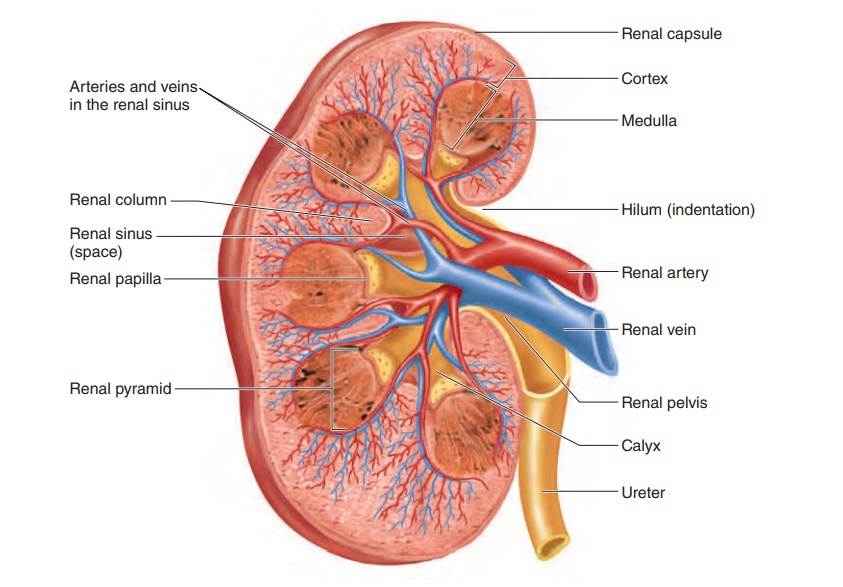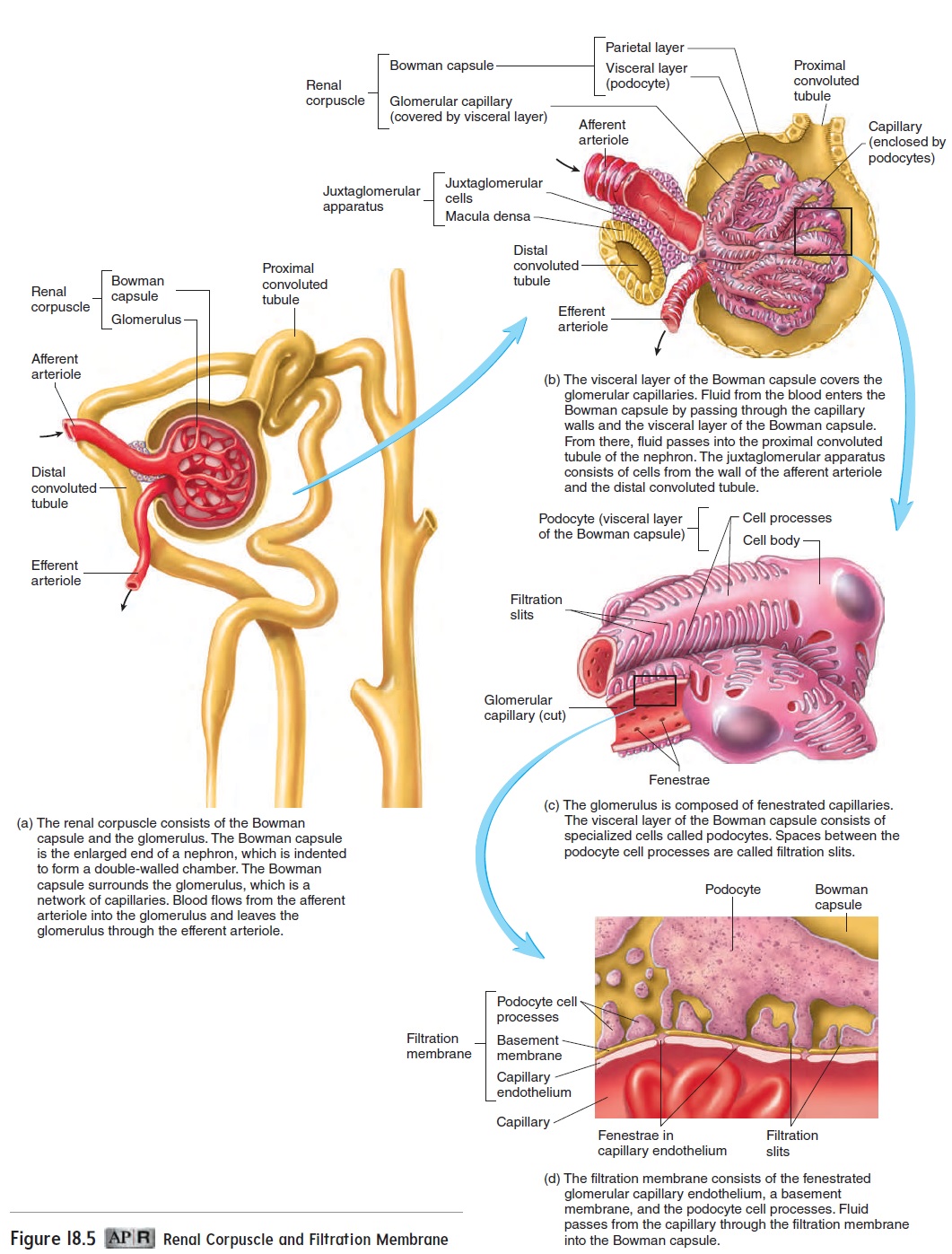Chapter: Essentials of Anatomy and Physiology: Urinary System and Fluid Balance
Anatomy of the Kidneys

ANATOMY OF THE KIDNEYS
The kidneys are bean-shaped organs, each about the size of a tightly clenched fist. They lie on the posterior abdominal wall, behind the peritoneum, with one kidney on each side of the vertebral column (figure 18.2). Structures that are behind the peritoneum are said to be retroperitoneal (re′trō-per′i-tō-nē′ăl). A layer of connective tissue called the renal (derived from the Latin word for kidney) capsulesurrounds each kidney. Around the renal capsule is a thick layer of adipose tissue, which protects the kidney from mechanical shock. On the medial side of each kidney is the hilum (hı̄′ lŭm), where the renal artery and nerves enter and where the renal vein, ureter, and lymphatic vessels exit the kidney (figure 18.3). The hilum opens into a cavity called the renal sinus, which contains blood vessels, part of the system for collecting urine, and adipose tissue.


The kidney is divided into an outer cortex and an inner medul-la, which surround the renal sinus. The bases of several cone-shaped renal pyramids are located at the boundary between the cortexand the medulla, and the tips of the renal pyramids project toward the center of the kidney. A funnel-shaped structure called a calyx (kā′ liks; pl. calyces kal′ i-sēz) surrounds the tip of each renal pyra-mid. The calyces from all the renal pyramids join to form a larger funnel called the renal pelvis. The renal pelvis then narrows to form a small tube, the ureter (ū-rē′ ter, ū′ re-ter), which exits the kidney and connects to the urinary bladder. Urine passes from the tips of the renal pyramids into the calyces. From the calyces, urine collects in the renal pelvis and exits the kidney through the ureter (figure 18.3).


The functional unit of the kidney is the nephron (nef′ ron; Greek for kidney), and there are approximately 1.3 million of them in each kidney. Each nephron consists of a renal corpuscle, a proximal convoluted tubule, a loop of Henle, and a distalconvoluted tubule (figure 18.4). Fluid is forced into the renal cor-puscle and then flows into the proximal convoluted tubule. From there, it flows into the loop of Henle. Each loop of Henle consists of a descending limb and an ascending limb. The limbs are further categorized into segments: the thin segment of the descending limb, the thin segment of the ascending limb, and the thick seg-ment of the ascending limb. The descending limb extends toward the renal sinus, where it makes a hairpin turn, and the ascending limb extends back toward the cortex. The fluid flows through the ascending limb of the loop of Henle to the distal convoluted tubule. Several distal convoluted tubules empty into a collectingduct, which carries the fluid from the cortex, through the medulla.Multiple collecting ducts empty into a single papillary duct, and the papillary ducts empty their contents into a calyx.

The renal corpuscle and both convoluted tubules are in the renal cortex (figure 18.4). The collecting duct and loop of Henle enter the medulla. Approximately 15% of the nephrons, called juxtamedullary(next to the medulla) nephrons, have loops ofHenle that extend deep into the medulla of the kidney. The other nephrons (85%), called cortical nephrons, have loops of Henle that do not extend deep into the medulla.
The renal corpuscle of the nephron consists of the Bowman capsule and the glomerulus (figure 18.5; see figure 18.4). The Bowman capsule consists of the enlarged end of the nephron, whichis indented to form a double-walled chamber. The glomerulus (glō-mār′ ū-lŭs) is a tuft of capillaries that resembles a ball of yarn and lies within the indentation of the Bowman capsule. The cavity of the Bowman capsule opens into the proximal convoluted tubule, which carries fluid away from the capsule. The inner layer of the Bowman capsule consists of specialized cells called podocytes (pod′ ō-sı̄ts), which wrap around the glomerular capillaries. The outer layer of the Bowman capsule consists of simple squamous epithelial cells.
The glomerular capillaries have pores in their walls, and the podocytes have numerous cell processes with gaps between them.
The endothelium of the glomerular capillaries, the podocytes, and the basement membrane together form a filtration membrane (figure 18.5d). In the first step of urine formation, fluid, consisting of water and solutes smaller than proteins, passes from the blood in the glomerular capillaries through the filtration membrane into the Bowman capsule. The fluid that passes across the filtra-tion membrane is calledfiltrate.

The proximal convoluted tubules, the thick segments of the loops of Henle, the distal convoluted tubules, and the collecting ducts consist of simple cuboidal epithelium. The cuboidal epitheli-al cells have microvilli and many mitochondria. These portions of the nephron actively transport molecules and ions across the wall of the nephron. The thin segments of the descending and ascending limbs of the loops of Henle have very thin walls made up of simple squamous epithelium. Water and solutes pass through the walls of these portions of the nephron by diffusion.
The thin segment of the descending limb of the loop of Henle is permeable to water and, to a lesser degree, solutes, and the thin segment of the ascending limb is permeable to solutes, but not to water.
Arteries and Veins
A system of blood vessels allows the exchange of materials that occurs in the kidneys. The renal arteries branch off the abdomi- nal aorta and enter the kidneys (figure 18.6a). They give rise to several branches. The interlobar (in-ter-lō′ bar; between the lobes) arteries pass between the renal pyramids and give rise to the arcuate (ar′kū-āt; arched) arteries, which arch between the cor- tex and the medulla.Interlobular arteries branch off the arcuate arteries and project into the cortex. The afferent arterioles arise from branches of the interlobular arteries and extend to the glo- merular capillaries (figure 18.6b).Efferent arterioles extend from the glomerular capillaries to the peritubular (around the tubes) capillaries, which surround the proximal convoluted and distal convoluted tubules and the loops of Henle. Thevasa recta (vā′ sărek′ tă; straight vessels) are specialized portions of the peritubular capillaries that extend deep into the medulla of the kidney and surround the loops of Henle and collecting ducts. Blood from the peritubular capillaries, including the vasa recta, enters the inter- lobular veins. The veins of the kidney run parallel to the arteries and have similar names (figure 18.6).

A structure called the juxtaglomerular (jŭks′ -tă-glŏ-mer′ ū-lăr) apparatus (pl.apparatuses) is formed where the distal convoluted tubule comes in contact with the afferent arteriole next to the Bowman capsule (see figure 18.5b). The juxtaglomerular apparatus consists of specialized cells of the walls of the afferent arteriole and the distal convoluted tubules. Certain cells of the juxtaglomerular apparatus secrete the enzyme, renin, and play an important role in blood pressure regulation (see “Hormonal Mechanisms” later).
Related Topics